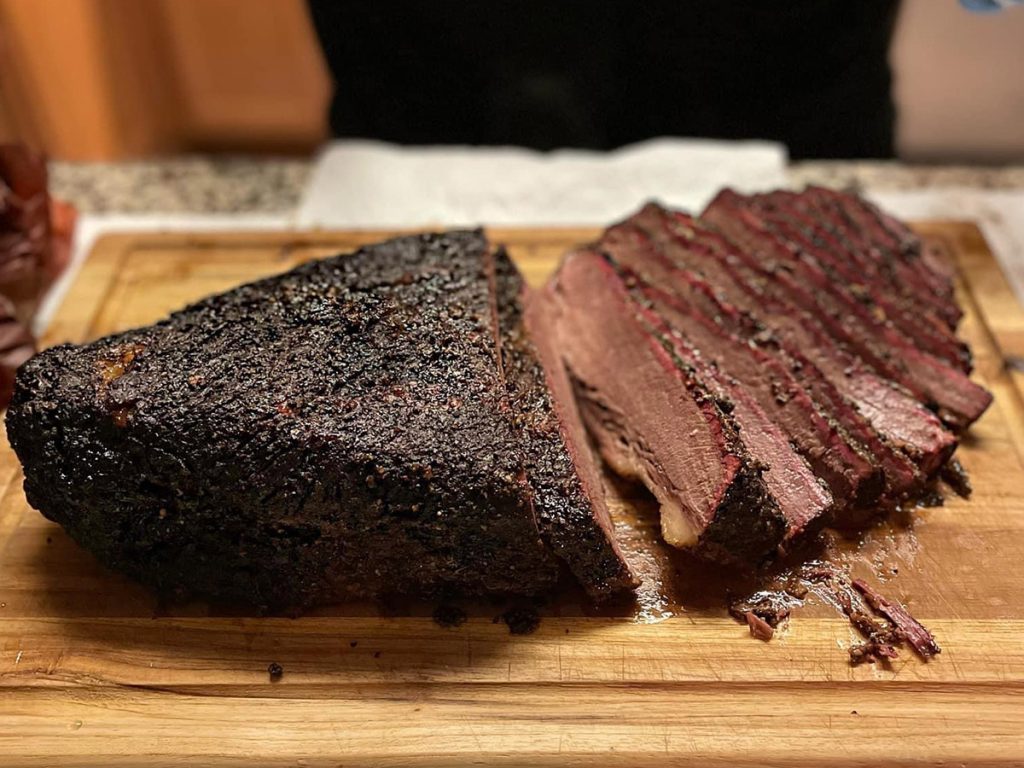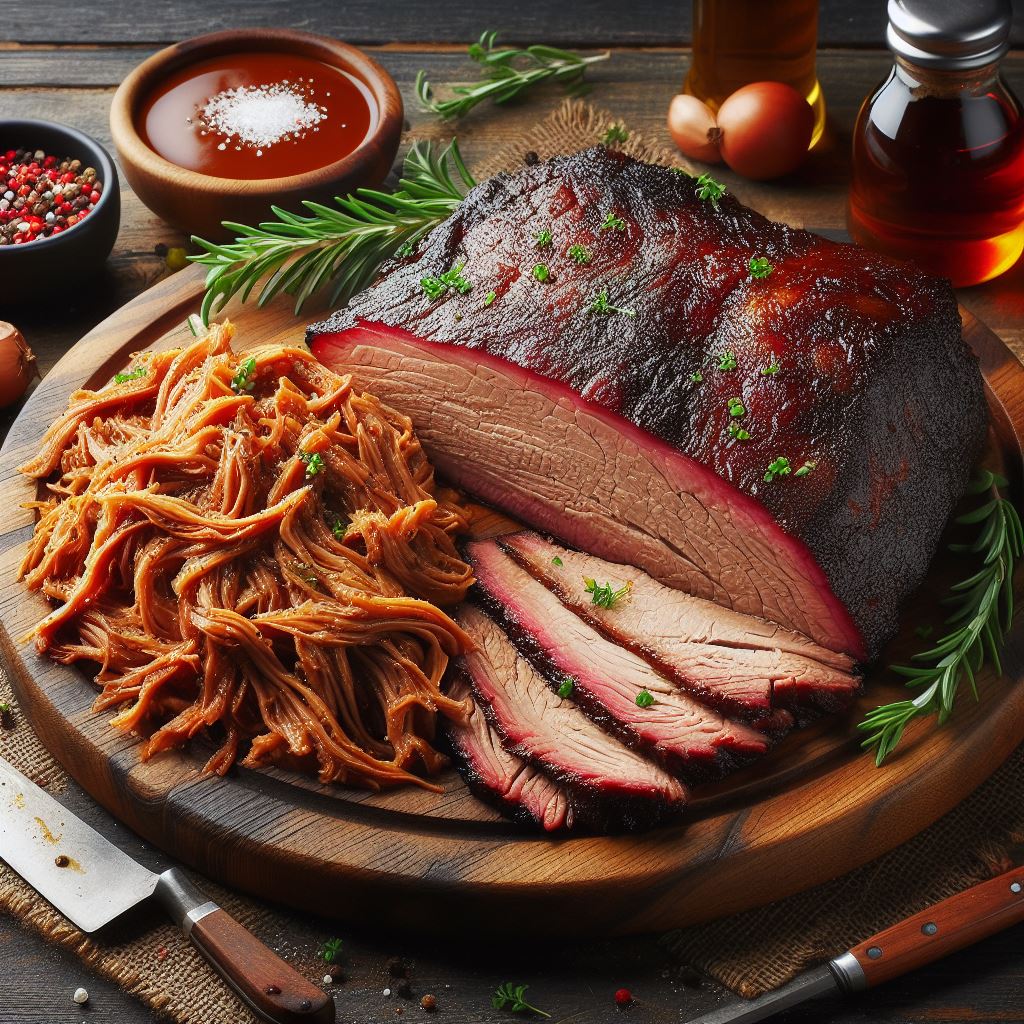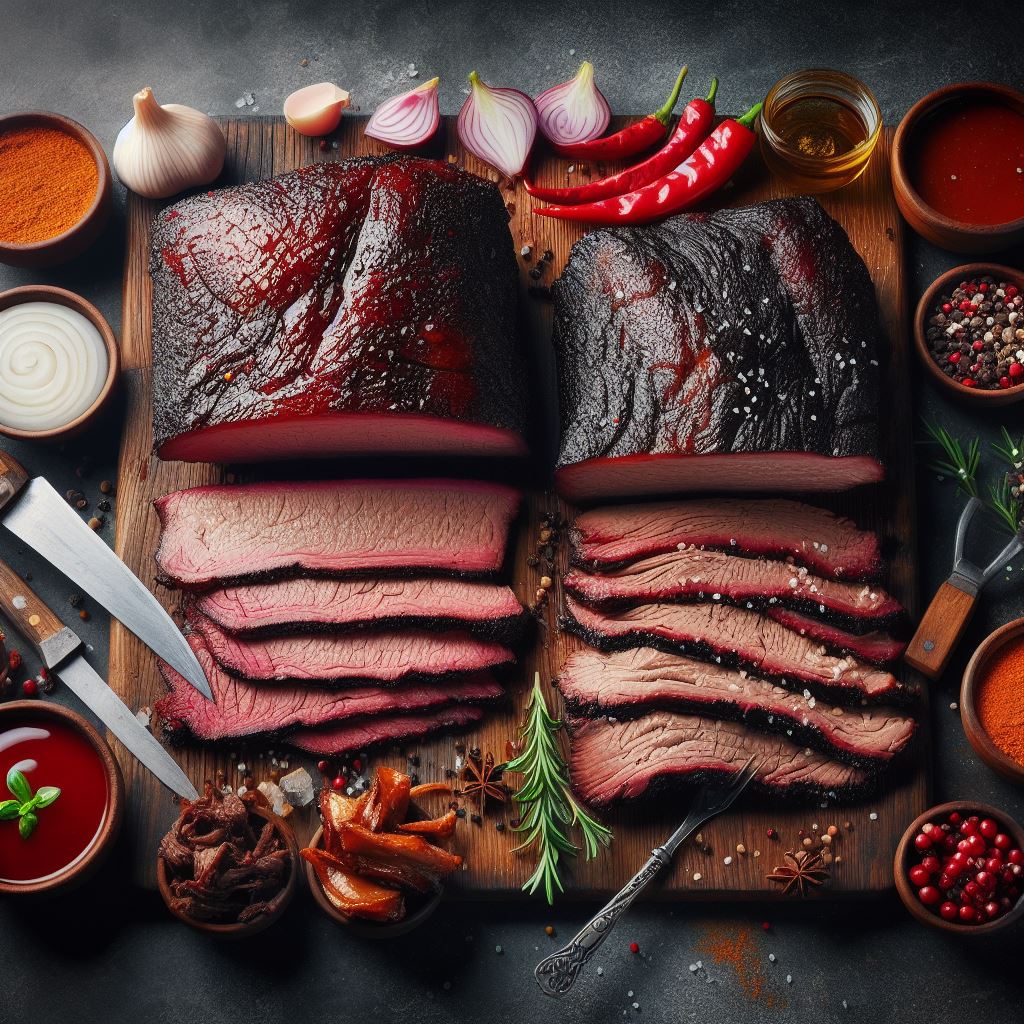The Great BBQ Showdown: Brisket vs. Pulled Pork
Brisket vs pulled pork are titans of the barbecue world, sparking friendly rivalries and mouthwatering cravings. Both boast unique flavors, cooking techniques, and regional pride, but which reigns supreme?
The King of Texas: Brisket
Brisket, a Texas-style staple, delivers a rich, beefy punch. Imagine melt-in-your-mouth tenderness achieved through slow smoking, a process that transforms tough cuts into masterpieces. Mastering brisket requires patience and skill—the low and slow cooking breaks down connective tissues and renders fat for an unforgettable taste.
Memphis Magic: Pulled Pork
Pulled pork, a Memphis favorite, offers a distinct flavor profile. Savory and slightly sweet, it owes its magic to dry rubs and tangy barbecue sauces. Cooked low and slow, the pork reaches a point of perfect shreddability, resulting in tender, succulent goodness.
Why We Love Them Both
Brisket and pulled pork have captivated BBQ enthusiasts for a reason. Let’s explore what makes each dish so special:
-
Brisket:
- Rich, beefy flavor profile
- Legendary melt-in-your-mouth tenderness
- The crown jewel of Texas BBQ
- A testament to pitmaster skill
-
Pulled Pork:
- Savory and slightly sweet taste
- Versatile for different dishes (sandwiches, tacos)
- Tangy kick from BBQ sauces
- Delivers succulent and tender meat
Table for quick comparison:
| Brisket | Pulled Pork | |
|---|---|---|
| Cut | It comes from beef, specifically the chest area | It comes from pork shoulder or pork butt |
| Flavor | Rich, smoky, melt-in-your-mouth | Savory, slightly sweet |
| Tenderness | It can be chewier but can achieve incredible tenderness | More tender due to higher fat content |
| Cooking Method | Low and slow smoking | Low and slow smoking or roasting |
| Versatility | It can be sliced or used in sandwiches and tacos | Shredded for sandwiches, sliders, or toppings |
| Difficulty Level | Requires time, patience, and skill | Slightly easier for beginners |
The Verdict: A Delicious Dilemma
Ultimately, the brisket vs. pulled pork debate boils down to personal preference. Do you crave the robust flavors and melt-in-your-mouth texture of brisket? Or are you drawn to the savory-tangy allure of pulled pork? Whichever you choose, both dishes showcase true barbecue’s artistry and deliciousness.
The Distinct Flavors And Textures
Brisket: Rich And Beefy Flavor With A Firmer Texture
Brisket offers a bold, beefy flavor and a tender, juicy texture that pairs perfectly with a savory dry rub or a tangy barbecue sauce. Known for its rich and beefy taste, brisket is a staple of Texas-style BBQ. It has a firmer texture that provides a satisfying chew.
The meat is slow-cooked through smoking or braising, allowing it to develop its distinctive flavors. Seasoned with salt, pepper, garlic, and paprika, brisket can be customized to suit individual preferences.
Pulled Pork: Moist, Tender, And Chewy With A Sweet And Smoky Taste
Pulled pork, on the other hand, has a succulent melt-in-your-mouth texture and a sweet, smoky flavor that is hard to resist. It is slow-cooked until it becomes moist, tender, and easily pulled apart with a fork. Hailing from Memphis-style BBQ, pulled pork has a slightly sweet profile thanks to dry rubs and tangy barbecue sauces. Its versatility allows it to be enjoyed in various BBQ styles, such as sandwiches or tacos.
Whether you prefer the satisfying chew of brisket or the tender pull-apart goodness of pulled pork, both types of meat have their place in the barbecue world. The brisket and pulled pork have distinct flavors and cooking techniques, making them beloved choices for barbecue enthusiasts. Each dish offers a unique culinary experience that can be customized to suit individual tastes.
Ultimately, you can’t go wrong with either option if you choose the rich beefiness of brisket or the succulent sweetness of pulled pork.

Cooking Techniques
Brisket: Smoked Or Braised For A Slow-cooked Perfection
Brisket requires slow-cooking methods like smoking or braising to break down tough connective tissues and achieve the desired tenderness and juiciness. Smoking involves cooking the brisket low and slow over indirect heat with aromatic wood chips, such as hickory or mesquite, to infuse it with a smoky flavor.
Braising, however, involves searing the brisket to develop a rich crust before simmering it in a liquid, such as beef broth or barbecue sauce, for several hours until it becomes tender and flavorful.
Pulled Pork: Slow-cooked To Achieve Its Tender And Juicy Consistency
Pulled pork is also slow-cooked to achieve its signature tender and juicy consistency. It is typically cooked using the “low and slow” method, where the meat is cooked at a low temperature, around 225-250°F (107-121°C), for a long time. This slow cooking process allows the pork to become incredibly tender and easy to pull apart with a fork.
The meat is often seasoned with a dry rub and then smoked or roasted until it reaches an internal temperature of around 195-205°F (90-96°C), resulting in a melt-in-your-mouth texture and a smoky flavor.
Whether you smoke or braise your brisket or opt for the low and slow cooking method for pulled pork, both require patience and attention to detail to achieve the desired level of tenderness and flavor. Each technique brings out the unique characteristics of the meat, making both dishes favorites among barbecue enthusiasts.
Seasoning And Customization
Brisket: Seasoned With Salt, Pepper, Garlic, And Paprika
Brisket is traditionally seasoned with a simple yet flavorful salt, pepper, garlic, and paprika rub. This combination enhances the natural beefiness of the meat and forms a delicious crust during the cooking process.
The seasoning can be adjusted to personal taste preferences, with some variations, including additional herbs and spices for added complexity.
Pulled Pork: Offers More Customization Options For Flavor Variations
Pulled pork offers a wider range of flavor customization options. The dry rub used for seasoning can be tailored to specific preferences, with variations that include smoky, spicy, sweet, or tangy profiles. Additionally, the choice of wood chips or pellets used for smoking can further influence the final flavor of the pulled pork, allowing for endless possibilities to suit individual tastes.
In conclusion, both brisket and pulled pork have unique qualities. Brisket’s traditional seasoning highlights its rich beefiness, while pulled pork provides more room for flavor experimentation. Whether you prefer the robust flavors of brisket or the customizable options of pulled pork, both dishes are sure to satisfy any barbecue enthusiast.
Brisket Vs Pulled Pork: A BBQ Showdown

Comparison Of The Distinct Flavors, Textures, And Cooking Techniques
Brisket:
- Slow-cooked through smoking or braising- Breaks down tough connective tissues for tenderness and juiciness- Smoky flavor infused through cooking with wood chips like hickory or mesquite- Rich beefy flavor with a tender, juicy texture
Pulled Pork:
- Slow-cooked through the “low and slow” method- Cooked at low temperatures for an extended period to achieve tenderness- Seasoned with a dry rub and then smoked or roasted for a smoky flavor- Melt-in-your-mouth texture with a sweet, smoky flavor
Consideration Of Personal Preferences And Individual Palate
- Brisket appeals to those who enjoy bold, beefy flavors and a savory taste.
- Pulled pork is favored by those who prefer a succulent, melt-in-your-mouth texture and a sweeter, smoky flavor.
- Brisket offers a traditional seasoning with salt, pepper, garlic, and paprika, while pulled pork allows for more customization in terms of flavor profiles.
- Cooking techniques for both dishes require patience and attention to detail to achieve the desired tenderness and flavor.
In the end, whether one leans towards the robust brisket flavors or the customizable options of pulled pork, both dishes will satisfy any barbecue enthusiast. The distinct flavors, textures, and cooking techniques of brisket and pulled pork make them the stars of any BBQ showdown.
Serving And Pairings
Best Ways To Serve And Enjoy Brisket And Pulled Pork
- Brisket is typically served as a main course on its own or in sandwiches.
- Pulled pork is versatile and can be served in various ways, including sandwiches, tacos, nachos, or even on top of pizza.
Recommended Sides, Sauces, And Accompaniments
- Traditional sides like coleslaw, mac and cheese, baked beans, or potato salad are popular choices for brisket.
- Pulled pork pairs well with sides like cornbread, baked beans, potato salad, or grilled vegetables.
- Barbecue sauces: Brisket is commonly served with a tangy, tomato-based barbecue sauce. Pulled pork can be enjoyed with a range of sauces, including sweet and smoky, tangy vinegar-based, or spicy options.
- Beverage pairings: Both brisket and pulled pork can be enjoyed with a cold soda, chilled beer, or refreshing iced tea. The choice of beverage depends on personal preferences and the overall flavor profile of the dish.
Remember, the key to serving and pairing these BBQ favorites is to complement the flavors, textures, and cooking techniques with delicious and complementary accompaniments. Experiment with different combinations to find your perfect match!
BBQ Culture And Regional Preferences
Exploring Regional BBQ Traditions And Preferences For Brisket Or Pulled Pork
Different regions have unique traditions and preferences when it comes to BBQ. In Texas, brisket is king, and it is often slow-smoked to perfection, resulting in tender and flavorful meat. Texans take great pride in their brisket, which is a staple at BBQ joints across the state.
On the other hand, Memphis-style BBQ is known for its pulled pork. This style of BBQ involves slow-cooking pork shoulder or butt until it becomes tender and easily pulled apart. The pork is typically seasoned with a dry rub and served with a tangy tomato-based sauce.
The preference for brisket or pulled pork often comes down to regional culture and tradition. Texas has a strong cattle ranching history, which may explain the popularity of brisket. In Memphis, pork has always been more readily available and affordable, leading to the prominence of pulled pork in their BBQ cuisine.
How do Different Areas Of The World Approach And Appreciate BBQ?
While BBQ is often associated with American cuisine, barbecuing traditions can be found in many parts of the world. Each region brings its flavors and techniques to the table.
In South America, for example, the traditional cooking method is called “Asado.” This involves slow-cooking large cuts of beef or pork over an open flame or a wood-fired grill. The meat is often marinated in chimichurri sauce, a flavorful blend of herbs, garlic, and vinegar.
In Asia, countries like Korea and Japan have their own BBQ traditions. Korean BBQ, known as “Gogigui,” involves grilling thin slices of marinated beef, pork, or chicken at the table. Japanese barbecue, or “Yakitori,” focuses on skewered and grilled bites of meat and vegetables.
In conclusion, BBQ is a global culinary tradition that varies from region to region. Whether you prefer the smoky flavors of Texas-style brisket or the tangy goodness of Memphis-style pulled pork, each has its unique appeal. Understanding and appreciating BBQ’s cultural and regional differences can deepen our enjoyment and understanding of this beloved cuisine.
Health And Nutritional Considerations
Comparison Of The Nutritional Values And Health Benefits Of Brisket And Pulled Pork
When comparing the health and nutritional values of brisket and pulled pork, there are some differences to consider. Here is a breakdown of the nutritional content per 3-ounce serving:
Brisket:
- Calories: 300
- Fat: 20g
- Protein: 30g
- Iron: 15% of the daily value
Pulled Pork:
- Calories: 250
- Fat: 16g
- Protein: 25g
- Iron: 8% of the daily value
As we can see, both meats are relatively high in calories and fat. However, brisket contains more fat than pulled pork, which has a slightly lower calorie count and fat content.
Potential Factors To Consider For A Well-balanced Diet
While both brisket and pulled pork can be enjoyed as part of a balanced diet, it’s important to consider a few factors:
- Portion size: Moderation is key when consuming high-fat meats like brisket and pulled pork. Opt for smaller serving sizes to maintain a balanced diet.
- Cooking method: The way these meats are prepared can affect their overall nutritional value. Grilling or smoking can release harmful compounds, so it’s important to choose healthier cooking methods like baking or roasting.
- Accompaniments: Pay attention to the sides and sauces that accompany these meats. To balance out the meal, opt for healthier options like grilled vegetables or a lighter sauce.
In conclusion, while both brisket and pulled pork have unique qualities and flavors, it’s important to consider the nutritional content and cooking methods when choosing. Incorporating these meats into a well-balanced diet can be enjoyed as part of a delicious and nutritious meal.
Conclusion
When it comes to choosing between brisket and pulled pork, it ultimately boils down to personal preference and the desired flavor profile for your BBQ feast. Both meats have unique qualities and flavors that make them beloved options in the world of BBQ. While brisket has a higher fat content, pulled pork has a slightly lower calorie count. Incorporating these meats into a well-balanced diet can be enjoyed as part of a delicious and nutritious meal.
When deciding between brisket and pulled pork, there is no right or wrong answer. It’s all about personal taste and what you enjoy. So whether you’re a fan of the melt-in-your-mouth tenderness of brisket or the savory, juicy goodness of pulled pork, both options will surely please your guests and create a memorable BBQ experience.
References:
- https://www.seriouseats.com/barbecue-brisket-recipe
- https://amazingribs.com/tested-recipes/pork-recipes/perfect-pulled-pork-recipe/
- https://barbecuefaq.com/pulled-pork-vs-brisket/
FAQ: Brisket Vs Pulled Pork: Decoding The BBQ Dilemma – Which One Wins Your Palate?
Q: What is the difference between brisket and pulled pork?
A: Brisket and pulled pork are two popular types of barbecue meats, but they differ in the cut of meat used and the cooking methods employed. Brisket comes from the beef section, specifically the chest area, while pulled pork is made from pork shoulder or pork butt.
Q: Which one is more flavorful?
A: Both brisket and pulled pork offer unique flavors that are hard to compare. When cooked properly, brisket boasts a rich and smoky taste with a melt-in-your-mouth texture. On the other hand, pulled pork offers a tender and juicy texture with a combination of savory and slightly sweet flavors.
Q: Which meat is more tender?
A: Regarding tenderness, both brisket and pulled pork can be incredibly tender when cooked well. However, traditionally, pulled pork tends to be more tender due to its higher fat content and longer cooking time. Brisket can be slightly chewier, but when cooked low and slow, it can also achieve incredible tenderness.
Q: How are brisket and pulled pork cooked?
A: Brisket is typically cooked low and slow, which means it is smoked at a low temperature for an extended period. This slow cooking process allows the fat to render down and the collagen to break down, resulting in tender and flavorful meat. Pulled pork is also cooked low and slow, usually smoked or slow-roasted, until the meat falls apart effortlessly.
Q: Is one meat more versatile than the other?
A: Both brisket and pulled pork can be used in various culinary applications, making them versatile. Brisket can be sliced thinly and enjoyed as a main dish or used in sandwiches and tacos. Pulled pork is often shredded and used in sandwiches, sliders, or topping for nachos and pizzas. It ultimately depends on personal preference and creative recipe ideas!
Q: Which one is easier to cook at home?
A: Cooking brisket and pulled pork requires time, patience, and skill. However, pulled pork can be slightly easier for beginners as pork shoulder or pork butt tends to be more forgiving and easier to handle compared to brisket. It is important to note that both meats require proper seasoning, temperature control, and monitoring to achieve optimal results.

The Stone’s Sports Grill and Bar was Established on December 1, 2021. The Stone is a Sequel to another restaurant called Cornerstone’s First Edition in Tucumcari, NM. This particular venue is located on the Southeast side of Colorado Springs. The Stone is Wide Open. We have a large dance floor, multi-level stage, pool room, (5) dart boards, and a bar with a large selection of wine spirits and brews.
